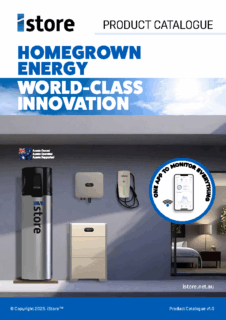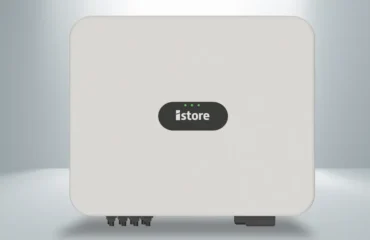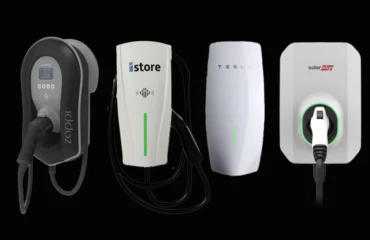
Charging your electric vehicle (EV) shouldn’t feel like waiting for paint to dry. You’ve got places to go and people to see! If charging via your current setup seems to take forever, it’s time to level up.
As EVs surge in popularity across Australia, so does the need for faster, smarter charging at home and at work.
3-phase EV chargers deliver more power, cut down charge times, and keep up with your lifestyle or business demands.
If you want to know what a 3-phase EV charger is, how it boosts charging speed, and what’s involved in installing one, you’re in the right place!
How Does a 3-Phase EV Charger Work?
A 3-phase EV charger uses a 3-phase power supply, which sends electricity through three separate wires at the same time. Because more power flows to your EV, it charges much faster than standard single-phase setups.
Think of it like filling up a water tank with three hoses instead of one!
Most modern EVs are designed to handle 3-phase charging, so you don’t need to worry about whether your car can keep up. And if your home or commercial site already has 3-phase power installed, you’re in a great position to take advantage of the faster charging a 3-phase EV can offer.
Benefits of 3-Phase EV Chargers
Faster charging isn’t the only advantage of 3-phase EV chargers.
- Efficiency: Higher power delivery means less energy loss during charging and less time drawing power from the grid, making your charging setup more energy-efficient overall.
- Scalability: Great for growing households or expanding commercial fleets. A 3-phase setup can handle multiple EVs and future upgrades without major changes to your existing electrical infrastructure.
- Future-Proofing: EV batteries are getting bigger. Installing a 3-phase charger now means you’re ready for the next generation of electric vehicles if you decide to upgrade your EV in future.
- Versatility: Perfect for both residential and commercial use, especially when faster turnaround times are essential, such as for households with multiple EVs, rideshare drivers, delivery vans, or business fleets.
- Compatibility with Solar: If you’ve got solar panels and a 3-phase solar inverter, you can make use of your available solar energy for more efficient and sustainable charging, reducing reliance on the grid and cutting energy costs.
Charging Speeds: 3-Phase vs. Single-Phase
Just how much faster can a 3-phase EV charger charge than a single-phase charger?
Single-phase chargers typically offer power outputs between 3.6 kW and 7.4 kW. Charging a 60 kWh battery with a 7.4 kW charger takes approximately 8 hours.
3-phase chargers can deliver between 11 kW and 22 kW, reducing the charging time for the same 60 kWh battery to about 3 hours. That’s almost 2.5 times faster charging!
Benefits of Fast Charging
Faster charging can make a big difference to your daily life.
- Convenience: Spend less time waiting and more time driving. Ideal for busy families, shift workers, or anyone on the go who needs to charge between school runs, meetings, or deliveries.
- Less Range Anxiety: Planning a road trip? Faster charging means shorter stops along the way and more confidence when driving longer distances.
- Easier Charge Sharing: In households or businesses with more than one EV, faster charging helps avoid delays and makes it easier to share a charger.
- More Flexibility: You’re not tied to charging overnight. You can plug in during the day and still get a full charge in just a few hours.
- Keeps Your Business Moving: For businesses, fast charging means less downtime for vehicles and more time on the road, boosting productivity and profits.
It’s important to know that fast charging can increase power consumption, so consider your energy needs and budget before investing in a 3-phase EV charger.
Who Should Consider a 3-Phase EV Charger?
| Typical User Situation | Single-Phase EV Charger | 3-Phase EV Charger | Reason |
| Single EV household | ✓ | Lower cost and sufficient overnight charging | |
| Apartment or townhouse with limited power | ✓ | Fits standard residential power supply and is easier to install | |
| Home or business with multiple EVs | ✓ | Supports faster charging and simultaneous charging of multiple vehicles | |
| Rideshare or delivery driver working daily | ✓ | Faster charging between shifts or during short breaks | |
| EV owner with residential or commercial solar energy setup | ✓ | Maximises the solar energy available from a 3-phase inverter for more eco-friendly and cost-effective charging | |
| Public or shared EV charging stations | ✓ | Ensures quick charging turnaround and high availability for multiple users |
How to Install a 3-Phase EV Charger
Site Assessment
Before installing a 3-phase EV charger, the first step is to check whether your property has 3-phase power available. Many newer homes and commercial buildings do, but older properties may only have single-phase power.
3-phase chargers require a compatible electrical supply. If your property doesn’t have a 3-phase system, an upgrade may be possible, but it will involve added costs and coordination with your energy provider.
A licensed electrician will carry out the site assessment. They’ll inspect your switchboard, meter, and main power supply to confirm whether 3-phase is installed and meets the EV charging requirements. If not, they can advise on what upgrades are needed and provide a quote.
It’s also a good time to assess things like charger placement, cable runs, and whether solar integration is part of the plan.
Equipment
You’ll need
- A 3-Phase EV Charger: Compatible with 3-phase power and supporting your EV’s onboard charging capacity.
- Wiring and Circuit Protection: Heavy-duty cabling rated for higher current, along with proper circuit breakers and safety switches.
- Mounting Hardware: Secure and weather-resistant hardware for wall-mounting or a stand.
Professional Help
Installing a 3-phase EV charger is not a DIY job! It involves working with high-voltage power and must comply with Australian electrical standards. Hiring a licensed electrician is non-negotiable.
They will make sure your setup is safe, reliable, and suited to your power supply and charging needs. They’ll also take care of any required certifications or paperwork.
What does the installation process involve?
Your installer will
- Confirm that your property has 3-phase power and that your switchboard is compatible.
- Install the charger, wiring, and any necessary safety devices, like circuit breakers or RCDs (safety switches designed to prevent electric shock).
- Secure the charger to a wall or stand in the chosen location (usually near your parking area).
- Connect the charger to your power supply and run safety and performance tests.
- Integrate the charger with your solar energy and battery system, if you have one.
- Show you how to use the charger and explain scheduling or solar integration features.
- Sign off on any required documentation to confirm the installation meets Australian standards.
Costs
The cost to install a 3-phase EV charger varies based on charger type, existing electrical infrastructure, and installation complexity.
3-phase EV chargers range from $1,000 to $1,300, depending on brand, features, and power output. Chargers with app control, load balancing, or solar integration may cost more but offer added convenience and efficiency.
General installation costs are as follows:
- Basic Installation: $500–$1,000 for properties with existing 3-phase power and minimal modifications needed.
- Complex Installation: $1,000–$2,500 for setups requiring longer cable runs, switchboard upgrades, or other modifications.
- 3-Phase Power Upgrade: $1,000–$3,000 to upgrade a property to 3-phase power, depending on location and existing infrastructure.
So, if your property has existing 3-phase power, the total cost can range from $1,500 to $2,300.
If the installation is complex or your property needs a 3-phase power upgrade, the total cost can be between $2,000 and $3,300.
Keep in mind that some states and territories offer rebates or incentives for EV charger installations. Check local programs to see if you’re eligible.
FAQ
Do I Need 3-Phase Power for an EV Charger?
You need a 3-phase power supply to install a 3-phase EV charger for faster charging.
A single-phase power supply is sufficient for standard home charging using a single-phase EV charger.
How Fast Is a 3-Phase EV Charger?
An 11–22 kW 3-phase EV charger can charge a 60 kWh battery in about 3 hours. That’s up to 2.5 times faster than a single-phase charger.
Can I Install a 3-Phase EV Charger at Home?
If your home has a 3-phase power supply, a licensed electrician can install a 3-phase EV charger. If not, you’ll need to upgrade your electrical system.
How Much Does It Cost to Install a 3-Phase EV Charger?
If your home already has 3-phase power, installation typically costs $1,500 to $2,300, including the charger.
If a power upgrade is needed, the total cost can rise to $2,000 to $3,300, depending on the setup and location.
Upgrade to a 3-Phase EV Charger With iStore
Power up in less time and keep moving with a 3-phase EV charger. You’ll get faster, more convenient top-ups and room to grow—perfect for busy households and businesses.
At iStore, we don’t just supply EV chargers; we deliver trusted, high-quality EV charging solutions backed by expert installation and support.
Explore the best 3-phase EV charger in Australia from iStore. Then, get in touch for advice or a quote by calling 1300 515 640 or filling out this online form.




